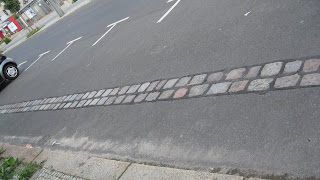

Middle: Mexico embassy in Berlin.
Right: Soviet TV tower,showing the Pope's revenge of the cross made by sunlight hitting the tower.
Berlin has many beautiful buildings, some restored to their original, and some completely new. I would like to describe some of these buildings and their significance to the city.
The first "building" I should show is the TV tower that the Soviets built in the eastern sector of the city. This tower is so huge that really, no matter where you are in the city, you can catch a glimpse of it. It is located on square known as Alexander Platz, a huge area with stores, eating areas and parks, and of course, the Ubahn station named for the Platz. I am not sure how lively it was during the Soviet era, but now it is full of people and places to shop and eat.
The TV Tower is really huge when you get close to it. It is a very tall tower, with a silver ball near the top. I think they actually had a restaurant in that silver ball once upon a time. The weird thing is that when the sun hits the ball, a silver cross appears on the ball. Everyone thinks that is pretty funny, since the communist's did not believe there was a God. Having the symbol of Christianity show up on their magnificent TV tower was very ironic. It is called the Pope's revenge.
I have already talked about the Reichstag, but this building is really a standout, and the glass dome makes it a must see for tourists. Museum Island is also a wonderful place to visit just for the buildings. There is also a Gendarme Marked square, located in Stadt Mitte. During Napoleon's time, the square housed the French army. Now it is a beautiful square, with the Concerthouse of Berlin, with the French Hugenot Church on one side, and the Lutheran Church on the other.
Berlin is full of shops and department stores, but the most famous one in KaDeVe, a huge department store in the Western part of Berlin. This department store has been in existence since the mid 1800's. We visited it and it is almost as good as Harrod's Department Store in London. Its nine floors are full of wonderful merchandize and boutique departments. On the top floor is the food market. Everything is up here: wine, sushi, desserts, meats, vegetables, pastries, exotic food from everywhere. Every area has a little bar where you can savor the food that is on sale there. It is beautifully done, and it was teeming with people the afternoon we were there. We poked around and looked at all of the displays, perfectly situated and lavishly decorated. Of course, Jack preferred to eat at the brotwirst stand outside, but we had a great time looking at everything in the store.
There is an area behind Potsdammer Platz where the national picture gallery is located. This building is a wonderful place to exhibit their rich collection of fine art. The building itself, on the outside, is a disappointment. Too much concrete and not enough greenery in front of the building. It is very near the Concert House of Berlin. This building is nondescript on the outside, and we were not sure if we liked the inside either. The orchestra is almost in the round, with seats running up and around the orchestra. Not so sure about the acoustics either.
Another building that is very interesting is the Bauhaus museum. The original Bauhaus school is now in Deshau, a small town west of Berlin. This school of design was very popular in the 1920's, with famous architects in charge, like Mies Van der Rohe, Gropius, and Corbusier. But the Nazi's considered their creations as degenerate and closed the school. Now Berlin has the museum of many of the works from that era. We had studied the architecture in our art history class, but the school also designed furniture, china, weavings and various other things for the home. The museum building itself is typical of a Bauhaus creation, very sleek and modern.
While we were in that part of the city, south of the Tier Garten, we walked around to see the many embassies. The "big guys" of America, Britain, Russia and France, had their embassies near the Brandenburg gate, but the rest of the world had its embassies down the road, in this more beautiful are. We saw about 20 different embassies, and the countries went all out to design the building as part of their culture. The Egyptian embassy was very beautiful, as well as the Spanish one and the Italian. The Mexican embassy was especially lovely. I have a photo of that one.
There is a famous street connecting the Brandenburg Gate area to the Stadt Mitte. It is called Unter den Linden. The King of Prussia planted numerous Linden trees down the street. They were removed decades later when the street became one of the most traveled, so that tram lines could be laid. It still is a very wide, beautiful street, with huge, baroque buildings on either side. One of the most famous was the Prussian guard house,designed by Schinkel. It is now a museum of peace.
There are hundreds of other buildings that are significant in some way, but I picked out a few to describe and give a flavor of Berlin.









